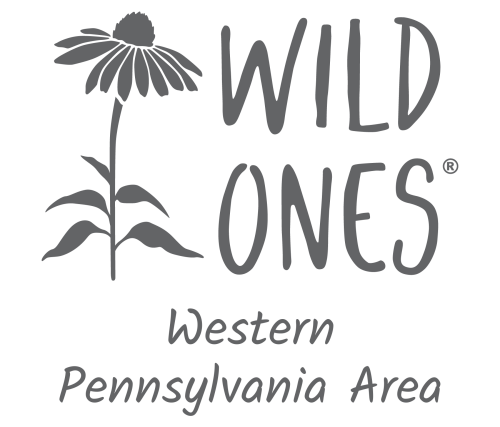Goldenrods are an important nectar source for insects in the late summer and fall and can be a vital part of your butterfly garden in Allegheny County. The genus name, Solidago, derives from the Latin words, Solidus and ago, which together mean to make (ago) whole (Solidus). This meaning comes from the medicinal uses of the plant. All of the species discussed in this post are perennials.
General Information about Native Plant and Pollinator Gardens
When planting a native plant and pollinator garden in Allegheny County, PA, you need to ensure that you have a selection of plants that attract other butterflies at different time of the year. Besides goldenrods, other host plants that attract other butterflies and pollinators should be considered. These could include pawpaw (Asimina triloba) for zebra swallowtail, wild cherry (Prunus serotina) for eastern tiger swallowtails, and trumpet creeper (Campsis radicans) for hummingbirds.
In addition to the plants, you need to provide a source of water such as a birdbath or water feature, shelter for animals, and nesting locations for birds. Be sure to include plants of different heights for perching. Resources you can use for more information on butterfly gardening in Allegheny County include the Penn State Master Gardeners of Allegheny County, Wild Ones Western Pennsylvania Chapter, Audubon Society of Western Pennsylvania, Xerces Society, and Phipps Conservatory and Botanical Garden.
Location of Allegheny County, Pennsylvania
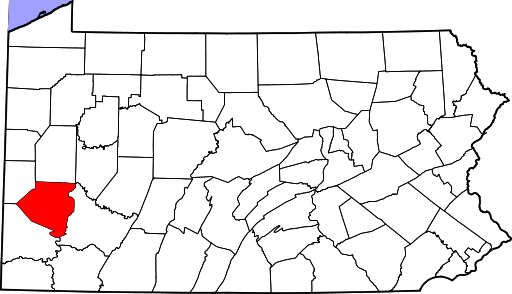
Allegheny County is located in southwestern Pennsylvania. Pittsburgh is the largest city in the county.
USDA Plant Hardiness Zones in Allegheny County, Pennsylvania
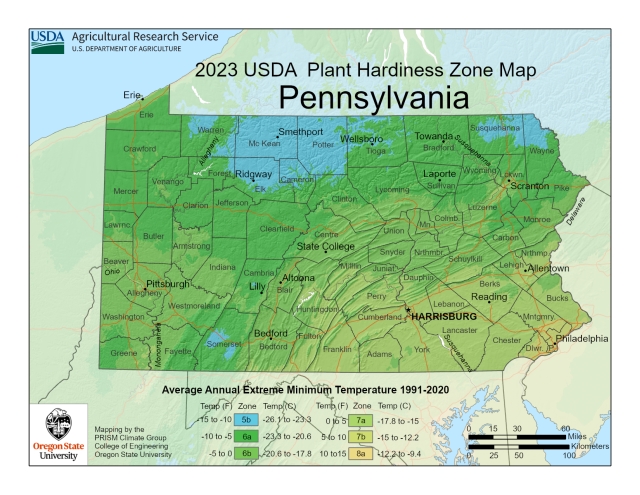
Allegheny County is located mostly within plant hardiness zone 6b. Adjacent to the Monongahela and Ohio Rivers is zone 7a. When selecting plants in Allegheny County, you will want to get those that can handle temperatures as cold as -50F.
Butterflies in Allegheny County, Pennsylvania that are hosted by Goldenrods (Solidago spp.)
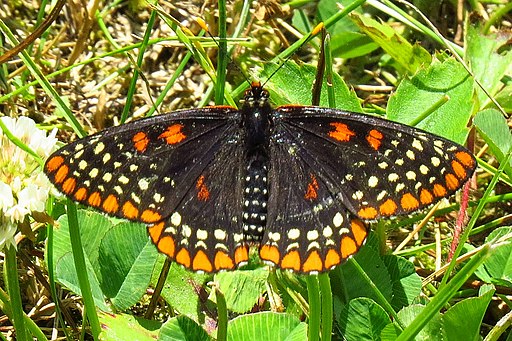
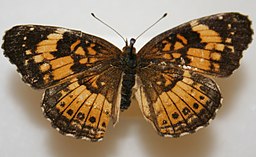
Baltimore Checkerspot (Euphydryas phaeton)
The Baltimore Checkerspot is a speckled white, orange and black butterfly. This butterfly is found in the eastern United States and southern Canada from the mid-west and east. Adults have a wingspan of 1.6 in (4.1 cm) to 2.5 in (6.4 cm).
The eggs of this species are yellow and become a reddish-tan color with age (wildadirondacks.org). The caterpillars are black with orange stripes (Pyle 1981). There is one brood that flies from May to July. This butterfly is so named because the color resembles the crest of Lord Baltimore (Pyle 1981).
Silvery Checkerspot (Chlosyne nycteis)
The silvery checkerspot is a muted yellow-orange color with a dark brown edge and middle. The hindwings have white crescent shaped edges. Adults have a wingspan of 1.4 in (3.6 cm) to 3.5 in (8.9 cm).
The greenish-white eggs are laid on the underside of the host plant leaves. The caterpillar is black in color and has small white spots. On the sides there may be yellow or orange stripes. In the early spring (March) in the south and late spring (June) in the north the adults emerge in one or two broods.
List of Goldenrods that are Native or Nearly Native in Allegheny County, Pennsylvania
1. Tall Goldenrod (Solidago altissima), a Goldenrod for Dry to Moist Soils
Along with the butterflies that are generally hosted by goldenrods, this species is also noted as hosting in some cases, the black swallowtail (Papilio polyxenes). When planted in a butterfly garden, this species needs about 2-3 feet of space and need to be watered frequently while being established. Suitable companion plants include purple-coneflower (Echinacea purpurea), black-eyed susan (Rudbeckia hirta), butterfly weed (Asclepias tuberosa), switchgrass (Panicum virgatum), and little bluestem (Schizachyrium scoparium). Tall goldenrod is known to spread, so it may need to be controlled by division or other means.
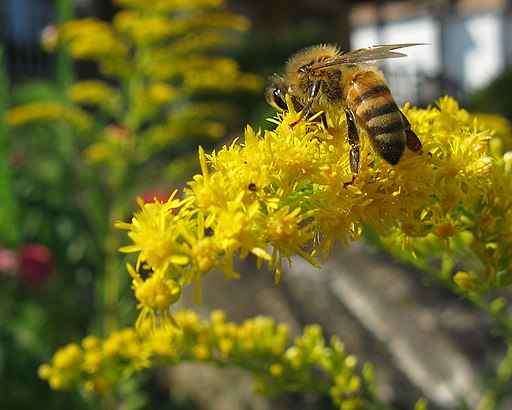
Facts about Tall Goldenrod
- Native to Pennsylvania: Yes (Kartesz 2015)
- Native to Allegheny County: Yes
- Natural Habitat:
- Height: 1 ft (0.3 m) to 4 ft (1.2 m)
- Flower Color: yellow ray and disk
- Flowering Period: August to October
- USDA Hardiness Zone: 5-10
Gardening with Tall Goldenrod
In your Allegheny County, PA butterfly garden this plant requires full sun to part shade and dry to moist soils. When planted it needs to be controlled since it can have weedy characteristics.
2. Atlantic Goldenrod (Solidago arguta), a Goldenrod for Well-drained Soils
Atlantic goldenrod can be planted in a variety of soils, so long as they are well-drained and neutral to acidic. Plants need to be spaced about 18 to 24 inches apart and watered regularly when being established. Suitable companion plants that have similar requirements include lance-leaf coreopsis (Coreopsis lanceolata), wild columbine (Aquilegia canadensis), New England Aster (Symphyotrichum novae-angliae), switchgrass (Panicum virgatum), and little bluestem (Schizachyrium scoparium). Like some of the other goldenrods, this species can spread in a garden situation.
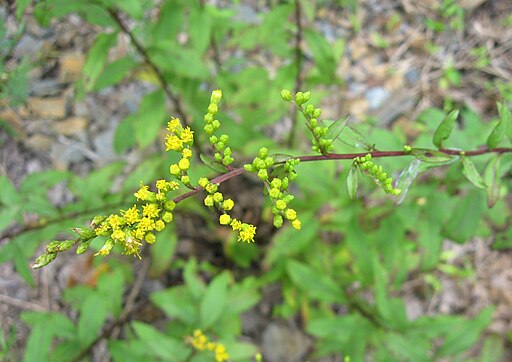
Facts about Atlantic Goldenrod
Solidago arguta var. arguta and S. arguta var. harrisii in Pennsylvania
- Native to Pennsylvania: Yes, essentially throughout the state (Kartesz 2015)
- Native to Allegheny County: Yes
- Natural Habitat: woodland openings, shaded roadsides, clearings, shale barrens (var. harrisii) (Flora of North America)
- Height: 1.5 ft (0.5 m) to 5 ft (1.5 m)
- Flower Color: yellow ray and disk flowers
- Flowering Period: August to October
- USDA Hardiness Zone: 2-8
Gardening with Atlantic Goldenrod
In your Allegheny County, PA butterfly garden, this plant requires full sun to part shade and well-drained soils.
3. White Goldenrod (Solidago bicolor), a Goldenrod for Sandy/Rocky, Well-drained Soils
White goldenrod is one of the few white colored goldenrods and is an interesting addition to your butterfly garden. Because of its narrow stature, it can be planted a little denser than some species are 12 in to 18 in apart. Suitable companion plants include purple coneflower (Echinacea purpurea), blue vervain (Verbena hastata), butterfly milkweed (Asclepias tuberosa), and hairy oat grass (Deschampsia flexuosa). If you need a white accent to an area that is sandy or rocky, this could be the goldenrod for you.
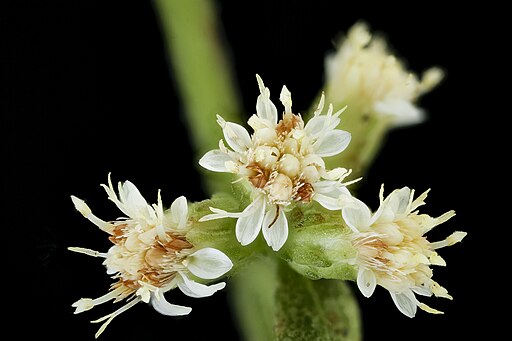
Facts about White Goldenrod
- Native to Pennsylvania: Yes, throughout (Kartesz 2015)
- Native to Allegheny County: Yes
- Natural Habitat: open woods and roadsides
- Height: 1 ft (0.3 m) to 3 ft (0.9 m)
- Flower Color: white
- Flowering Period: September to October
- USDA Hardiness Zone: 3-10
Gardening with White Goldenrod
In your Allegheny County, PA butterfly garden, this plant requires full sun to part-shade and well-drained soils.
4. Wreath Goldenrod (Solidago caesia), a Goldenrod for Dry to Medium Well-drained Soils
Wreath goldenrod is perfect for those gardeners who have a shaded exposure, but it can also grow in full sun. This species is often found at the bases of trees in wooded areas. Other companions in your garden with this species can include blazing star (Liatris spicata), other goldenrods (Solidago spp.), Joe-Pye weed (Eutrochium maculatum), clasping milkweed (Asclepias amplexicaulis), and hazelnut (Corylus spp.). This plant is known to be deer resistant and can handle rain gardens.
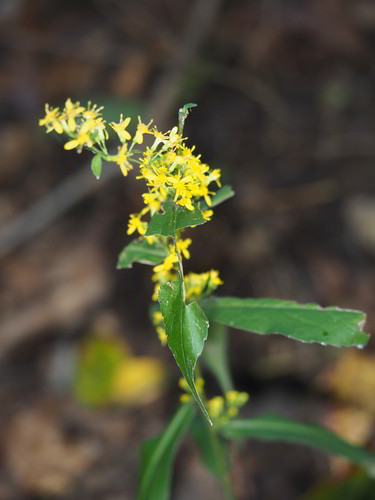
Facts about Wreath Goldenrod
Solidago caesia var. caesia in Pennsylvania
- Native to Pennsylvania: Yes, throughout (Kartesz 2015)
- Native to Allegheny County: Yes
- Natural Habitat: shaded wooded areas
- Height: 1.5 ft (0.5 m) to 3 ft (0.9 m)
- Flower Color: Yellow
- Flowering Period: August to September
- USDA Hardiness Zone: 4-8
Gardening with Wreath Goldenrod
In your Allegheny County, PA butterfly garden, this plant requires full sun to part shade and soils that are dry to medium and well-drained.
5. Canada Goldenrod (Solidago canadensis), a Goldenrod for All Soils
Canada goldenrod prefers places with full sun (can tolerate part-shade) and needs watering until established. If this species is chosen, care will need to be taken to ensure that it does not take over the garden as it spreads readily via rhizomes. A nice compliment to this plant in butterfly gardens is the New England Aster (Symphyotrichum novae-angliae), which forms a nice color contrast. Otherwise it it is happy with other butterfly plants such as Joe-Pye weed (Eutrochium spp.), New York ironweed (Vernonia novaboracensis), and milkweeds (Asclepias spp.).
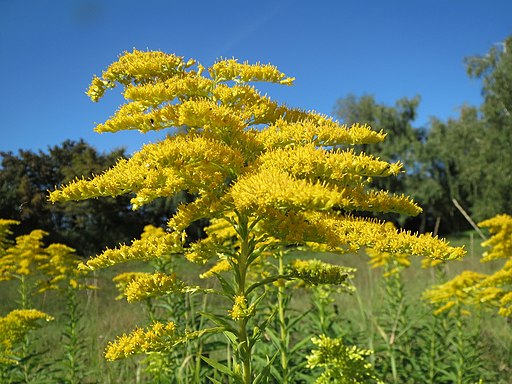
Facts about Canada Goldenrod
- Native to Pennsylvania: Yes, throughout (Kartesz 2015)
- Native to Allegheny County: Yes
- Natural Habitat: open areas such as fields, roadsides, and other disturbed areas
- Height: 2 ft (0.6 m) to 3 ft (0.9 m)
- Flower Color: Yellow
- Flowering Period: August to October
- USDA Hardiness Zone: 4-8
Gardening with Canada Goldenrod
In your Allegheny County, PA butterfly garden, this plant requires full sun to partial shade and handles most soils that are well-drained. This plant is very weedy and spread via rhizomes. If this plant is in the garden it needs to be controlled.
6. Curtis’ Goldenrod (Solidago curtisii), a Goldenrod for Dry to Moist Well-drained Soils
Curtis’ goldenrod is a rare plant in Pennsylvania and grows nearby to Allegheny County in Washington and Greene Counties. It enjoys full sun and generally moist soil, especially when first establishing and needs about 18 inches between plants for ventilation. Suitable companion plants include various asters (Symphyotrichum spp.), swamp milkweed (Asclepias incarnata), Joe-Pye Weed (Eutrochium spp.), and blazing star (Liatris spicata).
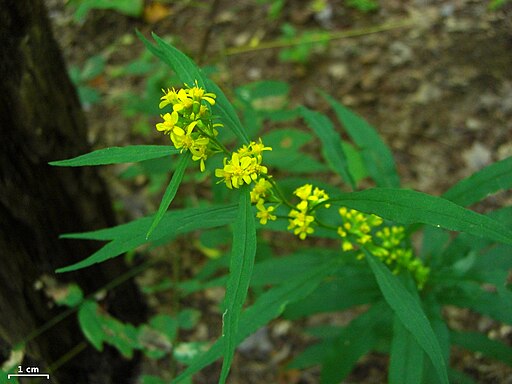
Facts about Curtis’ Goldenrod
- Native to Pennsylvania: Yes, rare in Washington and Greene Counties (Kartesz 2015)
- Native to Allegheny County: No
- Natural Habitat: shaded woods and thickets
- Height: 0.5 ft (0.2 m) to 4 ft (1.2 m)
- Flower Color: Yellow
- Flowering Period: August to October
- USDA Hardiness Zone: 5-8
Gardening with Curtis’ Goldenrod
In your Allegheny County, PA butterfly garden, this plant requires full sun to part shade and moist to medium well-drained soils.
7. Slender Goldenrod (Solidago erecta), a Goldenrod for Dry to Medium Soils
Slender goldenrod likes places that have full sun and needs to be spaced about 2 feet apart for space to spread and ventilation. Clumps of stems can be divided every 3-5 years. Plants that make a nice companion to this species and match its stature include wild geranium (Geranium maculatum), orange coneflower (Rudbeckia fulgida), switchgrass (Panicum virgatum), and little bluestem (Schizachyrium scoparium).
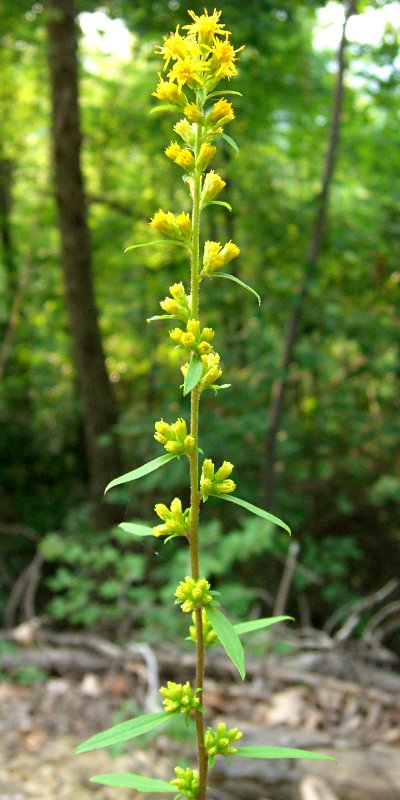
Facts about Slender Goldenrod
- Native to Pennsylvania: Yes, rare in southern counties (Kartesz 2015)
- Native to Allegheny County: No
- Natural Habitat: Dry woods, fields, and roadsides
- Height: 1 ft (0.3 m) to 4 ft (1.2 m)
- Flower Color: Yellow
- Flowering Period: August to October
- USDA Hardiness Zone: 3-8
Gardening with Slender Goldenrod
In your Allegheny County, PA butterfly garden, this plant requires full sun and dry to medium well-drained soils.
8. Zigzag Goldenrod (Solidago flexicaulis), a Goldenrod for Medium Well-drained Soils
Zigzag goldenrod likes places with full sun or part shade and medium moisture soil. Like a number of other goldenrods, it needs space for spreading and to be watered well while it is establishing. Companion plants in the garden include purple coneflower (Echinacea purpurea), blazing star (Liatris spicata), butterfly milkweed (Asclepias tuberosa), other goldenrods (Solidago spp.), and river oats (Chasmanthium latifolium).
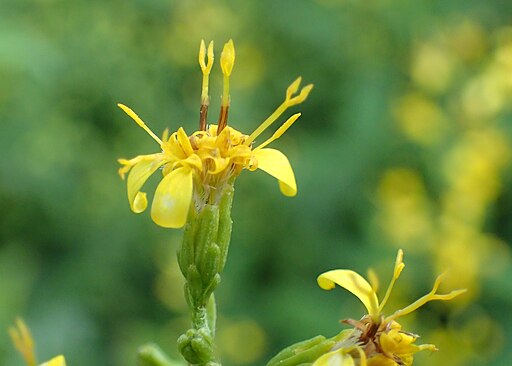
Facts about Zigzag Goldenrod
- Native to Pennsylvania: Yes, throughout, but scattered in central counties (Kartesz 2015)
- Native to Allegheny County: Yes
- Natural Habitat: forests, swamps, rocky woodlands, thickets
- Height: 0.5 ft (0.2 m) to 3 ft (0.9 m)
- Flower Color: Yellow
- Flowering Period: July to October
- USDA Hardiness Zone: 3-8
Gardening with Zigzag Goldenrod
In your Allegheny County, PA butterfly garden, this plant requires full sun to part shade and medium well-drained soils.
9. Late Goldenrod (Solidago gigantea), a Goldenrod for Medium to Wet Soils
This is one of the largest goldenrods in the area and pairs well with some of the larger plants that can be found in a butterfly garden. It also native to Allegheny County. It likes places of full sun to part shade and soils that are medium to wet. Other plants that also like this situation include sweet Joe-Pye weed (Eutrochium purpureum), New York ironweed (Vernonia novaboracensis), swamp milkweed (Asclepias incarnata), and blue vervain (Verbena hastata), and New England Aster (Symphyotrichum novae-angliae).
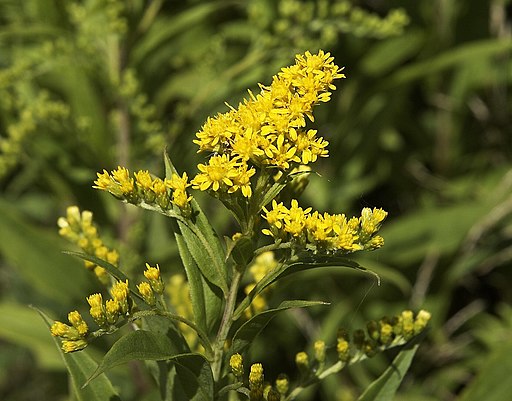
Facts about Late Goldenrod
- Native to Pennsylvania: Yes, throughout (Kartesz 2015)
- Native to Allegheny County: Yes
- Natural Habitat: floodplains, open woods, thickets, and grasslands
- Height: 3 ft (0.9 m) to 7 ft (2.1 m)
- Flower Color: Yellow
- Flowering Period: August to October
- USDA Hardiness Zone: 3-8
Gardening with Late Goldenrod
In your Allegheny County, PA butterfly garden, this plant requires full sun to part-shade and soils that are medium to wet and well-drained.
10. Hairy Goldenrod (Solidago hispida), a Goldenrod for Dry Sandy Soils
Hairy goldenrod likes to be in full sun and in soils that are medium to dry. While not native to Allegheny County, it can handle the plant hardiness zone. It is one of the shorter goldenrods, and pairs well with other shorter plants such as black-eyed susan (Rudbeckia hirta), phlox (Phlox divaricata), butterfly weed (Asclepias tuberosa), and fox sedge (Carex vulpinoidea).
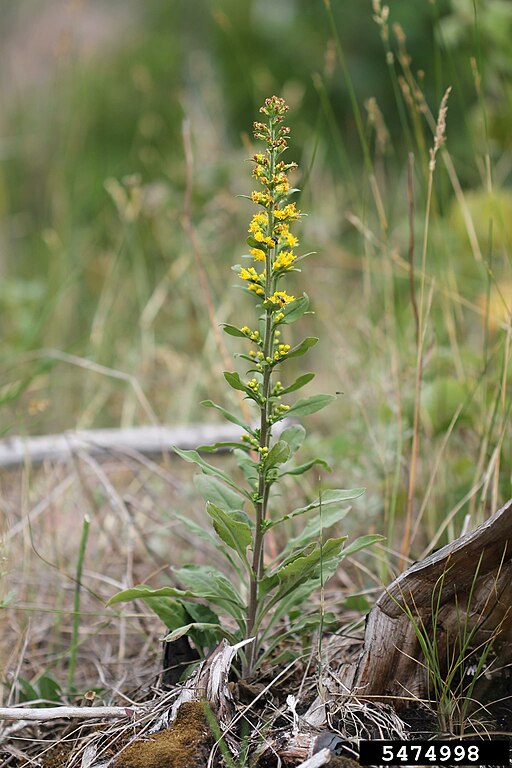
Facts about Hairy Goldenrod
- Native to Pennsylvania: Yes, mostly southern counties, scattered elsewhere (Kartesz 2015)
- Native to Allegheny County: No
- Natural Habitat: fields, meadows, open woods, rock outcrops
- Height: 1 ft (0.3 m) to 3 ft (0.9 m)
- Flower Color: Yellow
- Flowering Period: July to September
- USDA Hardiness Zone: 3-8
Gardening with Hairy Goldenrod
In your Allegheny County, PA butterfly garden, this plant requires full sun and soils that are medium to dry and well-drained.
11. Early Goldenrod (Solidago juncea), a Goldenrod for Dry to Medium Soils
If you want some early season yellow in your full sun garden and a plant that is native to Allegheny County, this species is for you. This species is a medium sized goldenrod that goes well with asters (Symphyotrichum spp.), river oats (Chasmanthium latifolium), many milkweeds (Asclepias spp.), and black-eyed susan (Rudbeckia hirta).
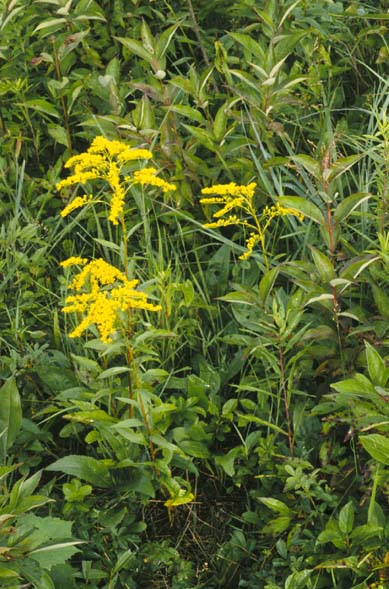
Facts about Early Goldenrod
- Native to Pennsylvania: Yes, throughout (Kartesz 2015)
- Native to Allegheny County: Yes
- Natural Habitat: fields and disturbed areas
- Height: 2 ft (0.6 m) to 4 ft (1.2 m)
- Flower Color: Yellow
- Flowering Period: July to September
- USDA Hardiness Zone: 3-8
Gardening with Early Goldenrod
In your Allegheny County, PA butterfly garden, this plant requires full sun and soils that are dry to medium and well-drained.
12. Gray Goldenrod (Solidago nemoralis), a Goldenrod for Dry to Medium Soils
Gray goldenrod is an unassuming short goldenrod that is fond of full sun and is an Allegheny County native. Soils need to be medium to dry and it goes well with other shorter plants such as clover (Trifolium spp.), fox sedge (Carex vulpinoidea), other goldenrods (Solidago spp.), and asters (Symphyotrichum spp.).
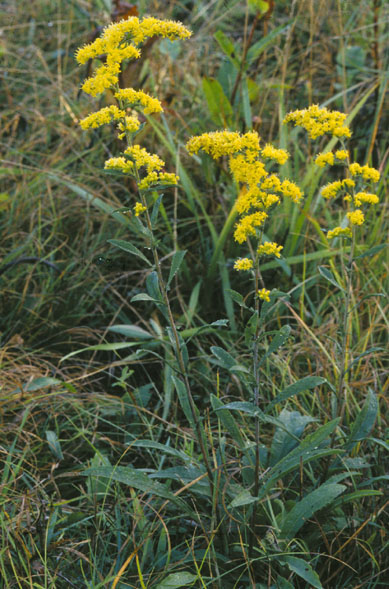
Facts about Gray Goldenrod
Solidago nemoralis var. nemoralis in Pennsylvania
- Native to Pennsylvania: Yes, throughout (Kartesz 2015)
- Native to Allegheny County: Yes
- Natural Habitat: prairies, fields, roadsides
- Height: 0.5 ft (0.2 m) to 2 ft (0.6 m)
- Flower Color: Yellow
- Flowering Period: August to October
- USDA Hardiness Zone: 3-9
Gardening with Gray Goldenrod
In your Allegheny County, PA butterfly garden, this plant requires full sun and soils that are dry to medium and well-drained.
13. Anise-scented Goldenrod (Solidago odora), a Goldenrod for Dry to Medium Soils
As the name would suggest, this goldenrod has a fragrance. It can grow in full sun to part shade and likes soil that medium to dry in moisture. Along with the early goldenrod, it is one of the first goldenrods to flower. Other companions include bee-balm (Monarda didyma), blue vervain (Verbena hastata), black-eyed susan (Rudbeckia hirta), and blazing star (Liatris spicata).
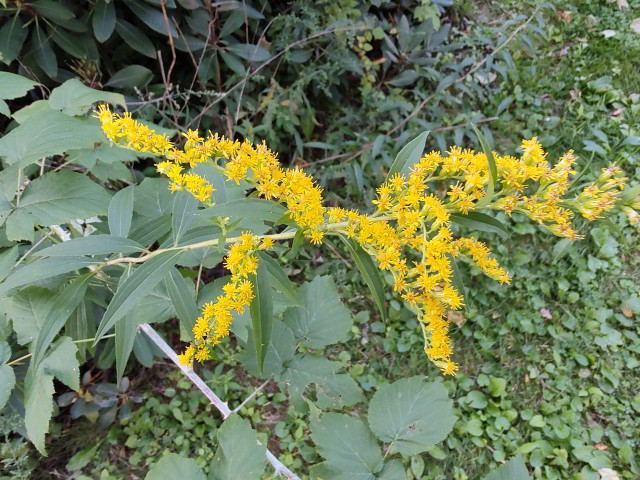
Facts about Anise-scented Goldenrod
Solidago odora var. odora in Pennsylvania
- Native to Pennsylvania: Yes, generally eastern counties (Kartesz 2015)
- Native to Allegheny County: No
- Natural Habitat: open woods, barrens, edges of woods, and roadsides
- Height: 2 ft (0.6 m) to 4 ft (1.2 m)
- Flower Color: Yellow
- Flowering Period: July to October
- USDA Hardiness Zone: 4-9
Gardening with Anise-scented Goldenrod
In your Allegheny County, PA butterfly garden, this plant requires full sun to part shade and soils that are medium to dry and well-drained.
14. Ohio Goldenrod (Solidago ohioensis), a Goldenrod for Moist Soils
Ohio goldenrod is not native to Pennsylvania, but as the name suggests, is native to Ohio. It is similar to the wrinkle-leaf goldenrod (Solidago rugosa), but has flowers that are little less dense. This species enjoys full sun, but can tolerate some shade and soils that are moist. Possible companion plants are similar to the other goldenrods.
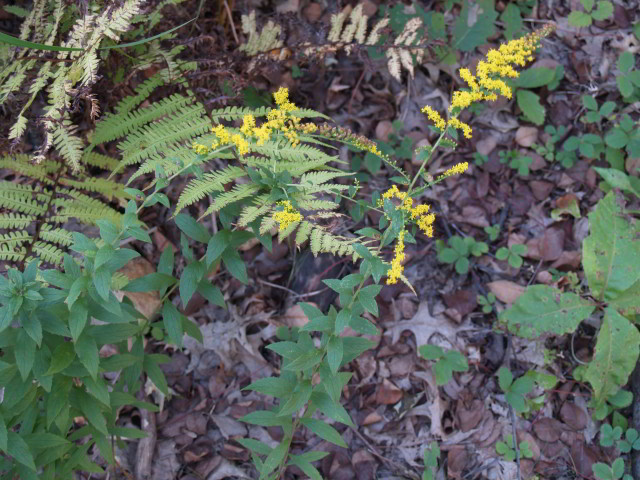
Facts about Ohio Goldenrod
- Native to Pennsylvania: No (Kartesz 2015)
- Native to Allegheny County: No
- Natural Habitat: wetlands, marshes, rivershores, and fens
- Height: 1 ft (0.3 m) to 4 ft (1.2 m)
- Flower Color: Yellow
- Flowering Period: September to October
- USDA Hardiness Zone: 4-9
Gardening with Ohio Goldenrod
In your Allegheny County, PA butterfly garden, this plant requires full sun and soils that are moist and well-drained.
15. Round-leaf Goldenrod (Solidago patula), a Goldenrod for Moist to Wet Sandy Soil
Round-leaf goldenrod, unlike some of the other goldenrods, enjoys partial shade and moist soils. Since it needs shade some trees or shrubs should be nearby as garden companions. Companions to this species in the garden could include swamp milkweed (Asclepias incarnata), purple coneflower (Echinacea purpurea), lanceleaf coreopsis (Coreopsis lanceolata), buttonbush (Cephalanthus occidentalis), and a larger tree(s) such as oaks (Quercus spp.). This species is native to Allegheny County.
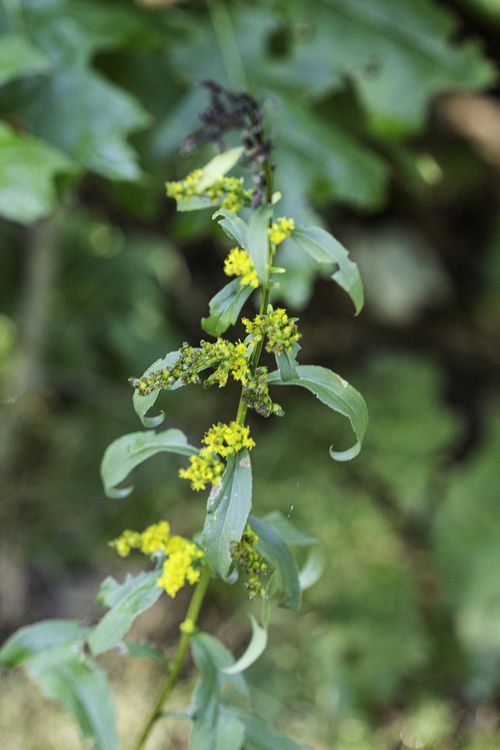
Facts about Round-leaf Goldenrod
- Native to Pennsylvania: Yes, western counties, scattered in east (Kartesz 2015)
- Native to Allegheny County: Yes
- Natural Habitat: wetlands, wet meadows, roadsides, edges of wet woods
- Height: 1.5 ft (0.5 m) to 5 ft (1.5 m)
- Flower Color: Yellow
- Flowering Period: August to October
- USDA Hardiness Zone: 3-8
Gardening with Round-leaf Goldenrod
In your Allegheny County, PA butterfly garden, this plant requires partial shade and moist to wet soils that are neutral in pH.
16. Downy Goldenrod (Solidago puberula), a Goldenrod for Dry Sandy/Rocky Soils
Downy goldenrod is another small goldenrod that is native in the central and eastern part of Pennsylvania. This goldenrod likes full sun and dry soils that are sandy or rocky. Because of the short-stature of the plant, plant neighbors need to be considered carefully. Some possible companions include anise-hyssop (Agastache foeniculum), bergamot (Monarda fistulosa), ironweed (Vernonia novaboracensis), and shorter forms of switchgrass (Panicum virgatum).
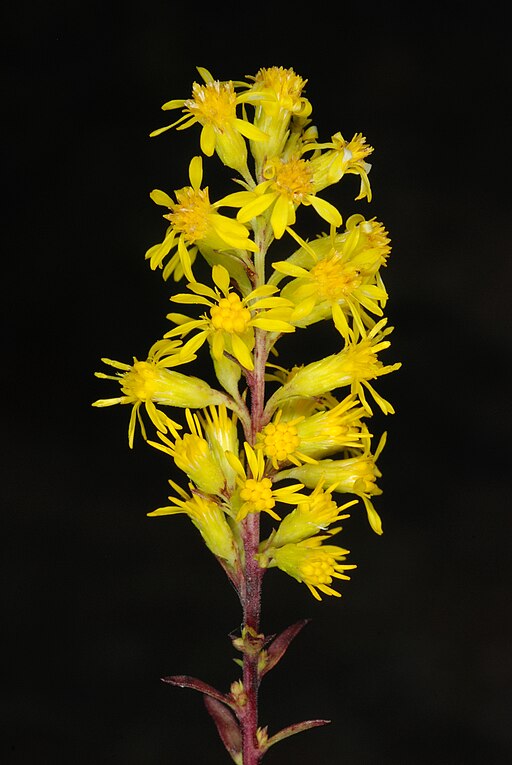
Facts about Downy Goldenrod
Solidago puberula var. puberula in Pennsylvania
- Native to Pennsylvania: Yes, central and eastern counties (Kartesz 2015)
- Native to Allegheny County: No
- Natural Habitat: open areas such as wood edges, fields, clearings, and roadsides
- Height: 0.5 ft (0.2 m) to 2 ft (0.6 m)
- Flower Color: Yellow
- Flowering Period: August to October
- USDA Hardiness Zone: 4-9
Gardening with Downy Goldenrod
In your Allegheny County, PA butterfly garden, this plant requires full sun and dry soils.
17. Hard-leaf Flat-top Goldenrod (Solidago rigida), a Goldenrod for Medium Soils
Hard-leaf Flat-top Goldenrod, is not native to Allegheny County, but handle the plant hardiness zone. It needs to be planted in open areas where it can get full sun. Interesting companion plants include blanket flower (Gaillardia aristata), threadleaf coreopsis (Coreopsis verticillata), common milkweed (Asclepias syriaca), beebalm (Monarda didyma), and stonecrop (Sedum spp.).
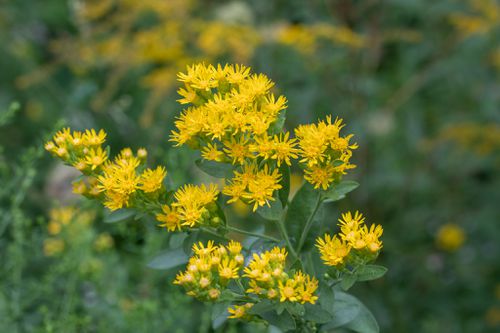
Facts about Hard-leaf Flat-top Goldenrod
Solidago rigida subsp. rigida in Pennsylvania
- Native to Pennsylvania: Yes, rare in central and eastern counties (Kartesz 2015)
- Native to Allegheny County: No
- Natural Habitat: prairies, glades, disturbed places, and dry open areas
- Height: 3 ft (0.9 m) to 5 ft (1.5 m)
- Flower Color: Yellow
- Flowering Period: August to September
- USDA Hardiness Zone: 3-9
Gardening with Hard-leaf Flat-top Goldenrod
In your Allegheny County, PA butterfly garden, this plant requires full sun and soils that have medium moisture and well-drained.
18. Wrinkle-leaf Goldenrod (Solidago rugosa), a Goldenrod for Medium to Wet Soils
Wrinkle-leaf goldenrod is an alternative to Canada goldenrod if you do not want a plant that invades the rest of the garden. Generally this goldenrod prefers full sun, but in gardens it can tolerate part shade. Companions to this plant are similar to the other goldenrods.
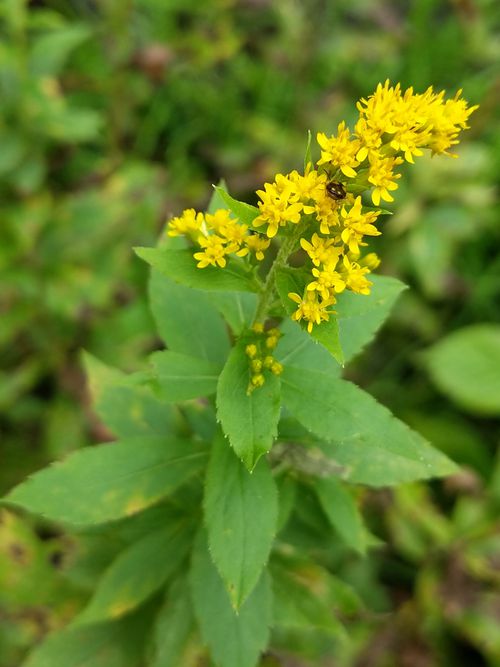
Facts about Wrinkle-leaf Goldenrod
Solidago rugosa ssp. aspera var. aspera, S. rugosa ssp. rugosa var. rugosa and sphagnophila
- Native to Pennsylvania: Yes, throughout (Kartesz 2015)
- Native to Allegheny County: Yes
- Natural Habitat: open areas such as woods edges, fields, and roadsides
- Height: 3 ft (0.9 m) to 5 ft (1.5 m)
- Flower Color: Yellow
- Flowering Period: August to October
- USDA Hardiness Zone: 4-8
Gardening with Wrinkle-leaf Goldenrod
In your Allegheny County, PA butterfly garden, this plant requires full sun (can handle part shade) and soils that are medium to wet.
19. Showy Goldenrod (Solidago speciosa), a Goldenrod for Medium to Dry Soils
Showy goldenrod is an Allegheny County native species that likes full sun and medium to dry soils. It is a small to medium sized plant that goes well with plants such as asters (Symphyotrichum spp.), obedient plant (Physotegia virginiana), bee-balm (Monara didyma), and little bluestem (Schizachyrium scoparium).
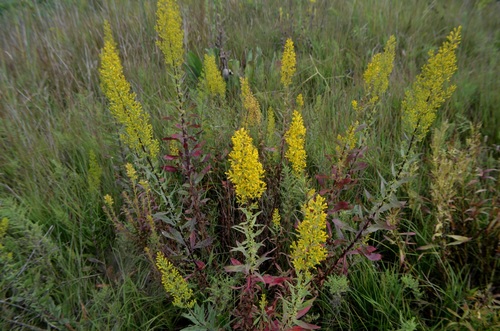
Facts about Showy Goldenrod
Solidago speciosa var. speciosa in Pennsylvania
- Native to Pennsylvania: Yes, rare and scattered throughout (Kartesz 2015)
- Native to Allegheny County: Yes
- Natural Habitat: open woods, fields, and roadsides
- Height: 2 ft (0.5 m) to 3 ft (0.9 m)
- Flower Color: Yellow
- Flowering Period: July to October
- USDA Hardiness Zone: 3-8
Gardening with Showy Goldenrod
In your Allegheny County, PA butterfly garden, this plant requires full sun and soils that are medium and well-drained.
20. Stout Goldenrod (Solidago squarrosa), a Goldenrod for Dry Soils
Stout goldenrod is an Allegheny County native that favors full sun and part shade on dry soils. Some companion plants that will provide a variety of heights and colors include cardinal flower (Lobelia cardinalis), wild geranium (Geranium maculatum), foxglove penstemon (Penstemon digitalis), and gray dogwood (Cornus racemosa).
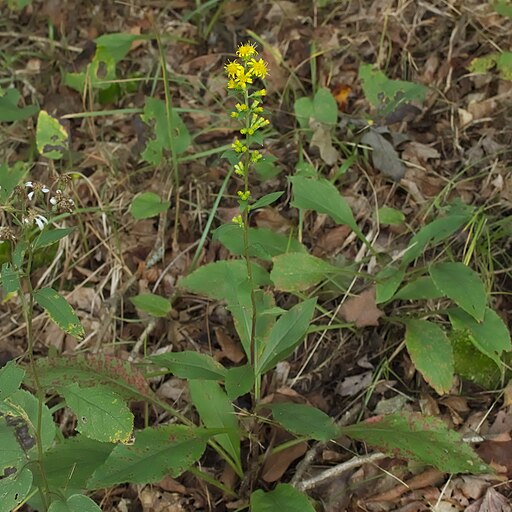
Facts about Stout Goldenrod
- Native to Pennsylvania: Yes, throughout (Kartesz 2015)
- Native to Allegheny County: Yes
- Natural Habitat: dry woods, fields, and rocky slopes
- Height: 1 ft (0.3 m) to 5 ft (1.5 m)
- Flower Color: Yellow
- Flowering Period: August to September
- USDA Hardiness Zone: 4-8
Gardening with Stout Goldenrod
In your Allegheny County, PA butterfly garden, this plant requires full sun to part shade and soils that are dry.
21. Elm-leaf Goldenrod (Solidago ulmifolia), a Goldenrod for Medium Soils
Elm-leaf goldenrod is a species with interesting leaves and adds a variety of texture in the garden. Suitable companion plants include New York ironweed (Vernonia novaboracensis), Asters (Symphyotrichum spp.), black-eyed susan (Rudbeckia hirta), spotted Joe-Pye weed (Eutrochium maculatum), and blue mistflower (Conoclinum coelestinum).
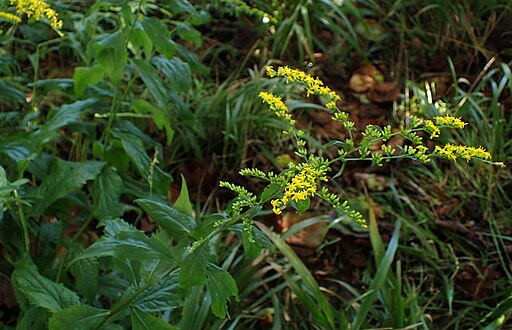
Facts about Elm-leaf Goldenrod
Solidago ulmifolia var. ulmifolia in Pennsylvania
- Native to Pennsylvania: Yes, throughout, scattered in northern counties (Kartesz 2015)
- Native to Allegheny County: Yes
- Natural Habitat: dry woods
- Height: 1 ft (0.3 m) to 3 ft (0.9 m)
- Flower Color: Yellow
- Flowering Period: August to October
- USDA Hardiness Zone: 3-8
Gardening with Elm-leaf Goldenrod
In your Allegheny County, PA butterfly garden, this plant requires full sun to part shade and medium soils.
Author’s Bio: Robert Coxe is the owner of McMullen House Bed & Breakfast LLC and Silphium Design LLC (a web development firm). Robert has a graduate degree in systematic botany and ecology and is the former State Ecologist of Delaware and a former ecologist at the Western Pennsylvania Conservancy. He is also a past-president of the Pennsylvania Academy of Science. Robert has a blog about native plant and butterfly gardens at the McMullen House Bed & Breakfast Garden Shop.
